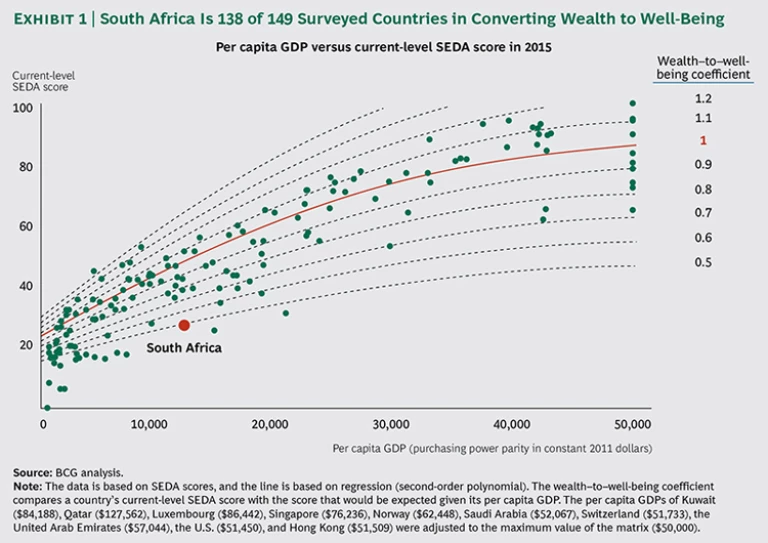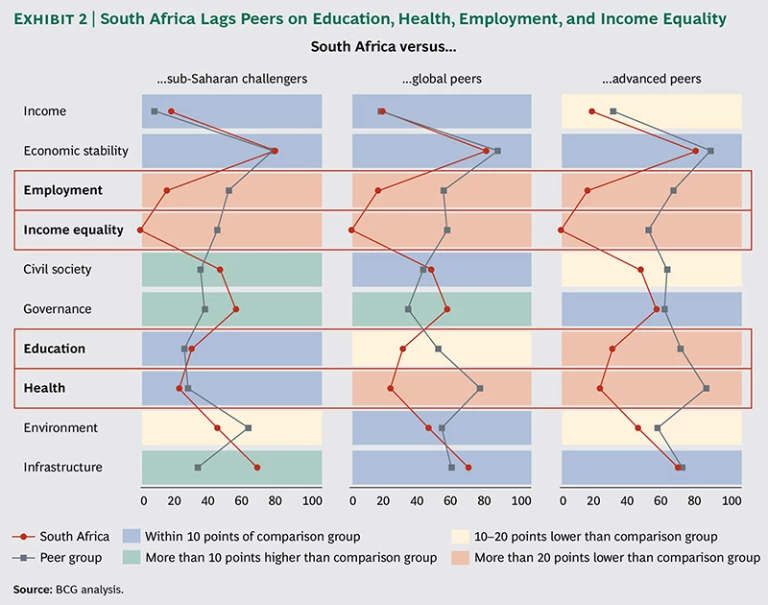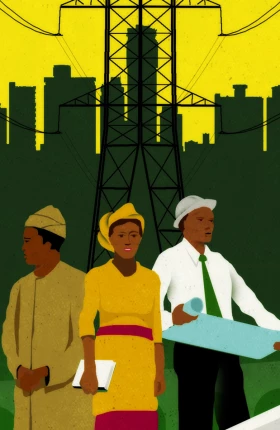South Africa has made tremendous progress in the 20 years since its first fully democratic election. The advances have occurred across multiple fronts: political, social, and economic. But as substantial as the progress has been, great challenges remain—complex issues of prosperity and well-being threaten to undermine South Africa’s continued development. Addressing those challenges will require strong public- and private-sector leadership in the years to come.
One critical issue is sustaining economic growth, which has slowed in recent years. But reigniting growth is only a first step. Equally important is understanding how South Africa can translate growth into the broader well-being of its people. Our most recent analysis using The Boston Consulting Group’s proprietary Sustainable Economic Development Assessment (SEDA) methodology shows that South Africa ranks 138 out of 149 economies in our SEDA database in terms of converting its wealth to well-being. (See Exhibit 1.) Delving deeper into the data and comparing a nation with peer groups of countries of similar size and economic and social characteristics highlights areas where high-impact solutions can lead to outsize improvement in overall standing. We compared South Africa with three groups of neighbors and peers: ten emerging economies from the region, eight countries with similar levels of development, and six global economies that have had per capita growth at least double that of South Africa and have demonstrated both consistent growth and a strong track record of translating growth into well-being.
The SEDA analysis reveals four critical dimensions in which South Africa’s performance impedes its ability to improve economic and social well-being: education, health care, employment, and income equality. (See Exhibit 2.) These four problem areas are intertwined components of a vicious circle that undermines prosperity and social well-being. For example, poor education results in a lack of skills, which contributes to high unemployment. High unemployment levels foster income inequality and slow economic growth, which in turn limit access to, and funding for, education; access to and funding for health care are similarly imperiled. Put another way, improving education is essential to breaking the circle in the long term, but improvement in employment, equality, and health care is necessary to improve well-being now. A summary discussion of these issues and what can be done to address them follows. An in-depth analysis is available here .
Education: Teach Your Children Well
Addressing education, where the problems are serious and systemic, is essential. Fortunately, the experiences of peer nations show that significant improvement is possible, even in the near term, and that targeted policies—policies that do not involve additional spending—make a difference. Four areas need attention:
- Teacher Quality. Statistics South Africa’s 2013 General Household Survey cites teacher-related issues as the top challenge facing public schools. Studies by the Southern and Eastern Africa Consortium for Monitoring Educational Quality, among others, have found that some 60 percent of people teaching math to grades one through six failed to pass tests for math at the grade level taught.
- Basic Skills. South Africa’s students perform poorly at math, science, and reading. Only 35 percent of sixth graders are numerate at an acceptable level (defined as answering 50 percent of the questions correctly on standardized math tests) and only 3 percent of ninth graders are numerate. According to the World Economic Forum’s Global Information Technology Report 2014, South Africa ranks last (144 out of 144) in terms of the quality of math and science education. Reading results are not much better. In the 2014 South African Annual National Assessment, only 48 percent of ninth-grade test takers achieved scores of 50 percent or better for “home language” literacy and only 18 percent achieved 50 percent or better scores for their first additional language.
- Dropout Rates. High secondary-school dropout rates undermine skill building and employability. According to the Department of Basic Education’s 2014 Country Progress Report, although 86 percent of 16- to 18-year-olds are in school, only 5 percent complete grade 12 by age 18, the expected age of completion. Other research shows that students completing grade 10 face only a 52 percent chance of employment. Completing grade 12 raises the probability of finding a job to 67 percent, but going on to postsecondary education improves one’s job-finding chances enormously—completing just one additional year increases the probability to 86 percent.
- Vocational Training and Higher Education. High dropout rates are exacerbated by the lack of training in vocational and practical skills. Further Education and Training (FET) colleges—schools that should provide vocational and practical-skills training—enroll about 200,000 students a year, but this is far from sufficient to compensate for current dropout rates. Moreover, FET colleges tend to provide theoretical training rather than practical, hands-on skill building, which makes them both less attractive to, and less helpful for, young dropouts.
The latest education-reform program (Action Plan 2014) addresses all of the critical issues, and its goals have been confirmed in the government’s National Development Plan 2030 (NDP). Numerous initiatives, with goals that include increasing the number and quality of teachers and improving reading, math, and science learning, are under way. The intentions are good, but the four problem areas are intractable. The impact of reform can be heightened by focusing on four priorities.
First, South Africans need to recalibrate their appreciation for the value of education and combine that newfound respect with a corresponding show of appreciation for teachers. This will happen only with leadership—from both government officials and role models in other areas of society.
Second, teaching quality needs to be measurable. Good teachers are central to turning around the educational system; they help improve learning and stem the dropout rate. Several poorly resourced schools in some of South Africa’s poorest communities achieve matric (university-qualifying) graduate rates of 90 percent of more, thanks to the quality and commitment of their teachers. They do this despite student-to-teacher ratios on the order of 30 to 1.
The experience of other systems—in Japan, Shanghai, and Finland, for example—shows that good teacher performance depends on being able to train, develop, and incentivize teachers properly. But in South Africa today, partly because of union rules, there is no consistent, systemic means of measuring performance, which means there is no systemic way to reward good teachers, identify underperformers, and make improvements. Given the strong role that the teachers’ union plays in the education system in South Africa, union involvement and cooperation are essential if the nation is to improve teacher quality.
Third, South Africa can strengthen vocational-training opportunities. South Africa should consider establishing a tiered education system that includes a clear potential route after grade nine into vocational training. This training should be financed by the government and allow students who choose this path to learn a skill that is geared to both their talents and the needs of the economy. Germany, where students can choose to enter vocational school at age 16, and approximately half do so, provides a good model.
The fourth priority is reducing dropout rates. Research shows that the three main reasons that 60 percent of men leave school early are lack of money for fees, poor academic performance, and a view that there is little value in continuing. The top three reasons for women, accounting for 62 percent of female dropouts, are lack of funds, family commitments, and poor academic performance. Better instruction on the link between education and employment, highlighting particularly the importance of math, science, and reading for most career options, can help. South Africa should also provide financial incentives, such as conditional grants to low-income families based on attendance, to help keep kids in school.
Health Care: Advancing Prevention, Accelerating Cures
Life expectancy in South Africa lags that in other countries. In the adult population, HIV/AIDS and its immune-system effects, which open the door to other killers such as tuberculosis, influenza, and pneumonia, remain the leading causes of death. About one-third of all deaths can be tied directly to these causes. Overall, the country is on the right track in addressing the HIV epidemic. South Africa has reduced HIV incidence since 1999 by more than 50 percent, and overall prevalence remains stable. Better education and prevention as well as the availability of improved antiretroviral treatments have increased overall life expectancy by four years since 2007.
Still, the war against HIV/AIDS is far from over. A key issue is the lack of integration of primary health-care facilities into rural communities, a shortcoming that leads to low rates of diagnosis and treatment and undermines South Africa’s integrated prevention, testing, and treatment approach to reducing HIV and TB incidence and coinfection. Community health workers should be used to address the gap by providing targeted health services and education in rural areas. Also, South Africa can focus more on reducing HIV incidence among high-risk groups, such as teenage girls. Additionally, South Africa should also accelerate its adoption of new treatments.
The main causes of death among South African children younger than five are related to poor hygiene and infectious diseases, which account for one-third of deaths in this age-group. Vaccinations are available to counter the impact of poor hygiene and infectious diseases, but South Africa has low immunization rates. For example, the immunization rates for measles and diphtheria are the lowest among all of the country’s peers. Low immunization rates do not currently lead to many deaths but do make South Africa susceptible to a major epidemic.
South Africa needs to focus on child mortality in the same way that it has attacked HIV/AIDS. Although substantial progress has been made in providing potable water nationwide (access to potable water increased from 60 percent in 1994 to 96 percent in 2012), lack of clean water and proper nutrition are still major problems in some areas and could worsen as a consequence of deteriorating water infrastructure. Improving maternal care is another priority, as is expanding immunization and vaccination coverage. Community health workers should be trained to communicate the importance of vaccinations for infants and children and to administer vaccines in remote areas.
Unemployment: The Tough Job Ahead
Unemployment is a structural, long-term problem in South Africa. At 25 percent, the country’s unemployment rate is significantly higher than that of its peers (a range of 7 to 13 percent), and there has been no material improvement in South Africa in recent years, while the nation’s peers have shown improvement.
Several factors shape South Africa’s unemployment landscape, starting with education. Constraints on small businesses are a second problem. Although small, medium, and micro enterprises (SMMEs) provide more than half of all jobs, their potential for growth and job creation is constricted. SMME owners and executives pointing to factors that hold back the growth of their businesses frequently cite poor access to credit, bureaucratic red tape, and policies that discourage entrepreneurship.
The rigidity of the labor market also constrains employment growth. On labor-market efficiency (a combination of market flexibility and efficient use of talent), South Africa ranks 113 out of 144 countries, according to the World Economic Forum—a decline from 76 in 2006. South Africa has the lowest score among all its peers for relations between labor and employers. Rigid rules that limit employer flexibility with respect to hiring, firing, and wages are exacerbated by low labor productivity and frequent unrest.
The government’s NDP sets high ambitions for improving the employment picture, with a goal of reducing the unemployment rate to 14 percent in 2020 and 6 percent in 2030. It also aims to increase workforce participation from 54 percent in 2010 to 65 percent in 2030. To achieve these objectives, the economy needs to add some 9 million jobs (to the current base of 15 million) by 2030.
The government is focusing on the right areas. The NDP cites four priorities: transforming the economy (including creating an environment in which SMMEs can thrive); stimulating SMME growth by addressing the regulatory environment and skills gap, among other measures; reforming the labor market; and providing postschool skill development for workers.
Reforming the labor market is a particularly important priority, and the NDP sets out several useful initiatives. One is to revisit the dismissal process, which currently ties employers’ hands, with the goal of making employee dismissals much simpler and thus reducing a big impediment to hiring.
In another positive step, the government has attempted to address South Africa’s skills gap through the dedicated Skills Education and Training Authorities (SETA), which consists of 21 agencies, each with the primary objective of developing the skills needed to fill jobs in its economic sector (such as agriculture, banking, and information and communications technology). To date, however, the SETA agencies have struggled with poor corporate governance and have lacked the strategic focus necessary to build demand-led skill development. SETA also needs to provide employers and employees with greater incentives to engage with the labor market. The SETA agencies should focus on promoting training for high-demand skills while incentivizing (or even requiring) large companies to take on interns and apprentices.
Welfare and Well-Being: The Best of “Frenemies”
Despite strong improvements in standards of living, South Africa continues to suffer from severe income inequality. The percentage of people living in the three poorest groups (designated by living-standard measure, or LSM) dropped from 42 percent in 1994 to 11 percent in 2013, but South Africa still ranks 148 out of 149 countries on the World Bank’s income-equality scale, ahead of only Haiti.
More than 30 million South Africans—almost 60 percent of the population—still live in the marginalized class, with annual incomes of less than R7,428 ($617). A typical consumer in this class has an income of about R619 a month and basic expenses—food, rent, utilities, and transportation—of R1,102, a shortfall of R483. Debt is a recourse for many, and going without is the only “choice” for many more. The number of people on social grants disbursed through the government’s welfare system increased from 2.7 million in 1994 to more than 17 million (some 30 percent of the population) in 2014.
One result is that welfare takes up almost a third of all money paid in income tax. This is a necessary evil for South Africa, at least in the near term. Discontinuing welfare, or substantially reducing the amount paid out, would cause another 3.3 million or more households to fall into poverty.
The longer-term risk, however, is that welfare will create long-term dependencies that recipients will have a hard time shaking off. A key long-term goal for South Africa must be to vastly reduce the role that welfare plays in the economy and in supporting people’s lives. The means of doing so, of course, is to strengthen the economy overall, particularly through the recommendations presented earlier in this report, in the sections on education and employment. In the near term, South Africa can take steps to make the welfare system more efficient and to use it to support long-term goals. Most significantly, welfare payments should be made conditional and tied to broader social and economic goals, such as incentivizing education, skill acquisition, and regular health checkups and testing. Several countries, particularly in Latin America, have used welfare reduction programs to positive effect.
Future Prosperity Depends on Leadership Now
What will South Africa look like in 20 years’ time? Will the potential to translate the country’s enormous wealth and potential into pervasive well-being have been realized?
There is ample reason for hope. South Africa has significant strengths. These include strong institutions, such as the national judiciary, a good transportation infrastructure (roads, airports, seaports, rail), highly developed financial markets, a sound banking system, strong capital market regulation, and generally good access to financing for businesses (although this is sometimes difficult for small businesses). South Africa has a large domestic market, with strong local suppliers of basic goods and services, and the business environment is competitive. The country’s proximity to high-growth African markets is a plus; many South African companies have taken advantage of geography by building significant businesses on the continent from a South African base. South Africa’s enormous mineral resources earn foreign currency and attract investment for growth, and the country’s outstanding natural beauty draws almost 10 million tourists a year as South Africa claims an increasing share of the global tourism market.
With fast-rising smartphone penetration, the digital economy can play a big role as well. The digital economy is already on par in size with the electricity, gas and water, and agriculture, forestry, and fisheries sectors,. It is expected to contribute $14 billion, or 2.5 percent, to national GDP in 2016 (double its contribution in 2010).
The strengths are in place and the solutions to the problems we have detailed in this report are straightforward and proven. They have been shown to work time and again in countries around the world. But—and this is a big but—a concerted program of execution is essential. In many instances this will mean putting the greater good ahead of individual or institutional interests. Those engaged in public service need to put the public first without exception. Business and labor leaders have their own constituencies to answer to, but they should also remember that a rising economic tide lifts all boats.
Leadership must come from both the public and private sectors—and from all levels of society. Political leadership is essential, of course, but leadership needs to extend beyond the government. Leaders in business and labor must look to the future and work together toward common goals. Parents can lead by getting involved in the education of their children; teachers, by committing to do their jobs better; communities, by conferring the respect that these professionals deserve. Everyday citizens can demonstrate their commitment by taking care of their health and taking advantage of the resources that are, and will become, available to help them acquire skills and jobs.
Hope for a better future has carried South Africa a great distance. Hope can continue to shoulder this burden, but hope is fueled by progress, and the rate of progress needs to pick up. During the transition from apartheid to a full multiracial democracy, South Africa demonstrated that it has the capacity for the kind of extraordinary leadership that inspires the world. It is time to reach deep into that reservoir again.












